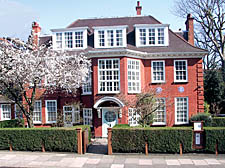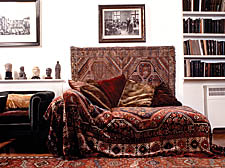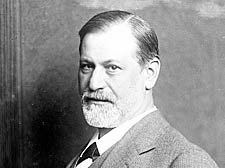|
|
 |
| |

The Freud Museum

Sigmund Freud's couch

Sigmund Freud |
The house of sex and dreams
Where better to celebrate the 150th anniversary of Sigmund Freud's birth than at the Freud Museum? writes Gerald Isaaman
There is inviting lilac at the entrance, bright marigolds in the flower beds amid the green lawns and two blue plaques are set into the red-brick front wall. Number 20 Maresfield Gardens, Hampstead, is a unique and kaleidoscopic place of fears, emotions and history.
This is the Freud Museum, the shrine to the father of psychoanalysis, to which visitors from around the world stream in pilgrimage, to the house where Sigmund Freud died from cancer in 1939, and where his undaunted daughter, Anna, continued his pioneering work until her death in 1982.
This is the house where sex and dreams and the complexities of our libidos were courted and interpreted, now a museum dedicated to them both, the home where Freud, a refugee from Nazi-annexed Austria, spent his final days as World War II burst into flames.
This is where you can see his celebrated and remarkably comfortable couch on which his patients reclined, covered with an Iranian rug with chenile cushions piled on top, the floor and tables covered too with rich oriental rugs, just as they were was when Freud was alive.
But this is the 150th anniversary of Freud’s birth – and coincidentally the 20th anniversary of the opening of the Museum – and you can now view life from Freud’s own armchair, placed before his writing table in his study in special exhibition where you can also see his art collection.
“When I sit down to write and take my pen in my hand I am always curious what will then follow,” Freud wrote. “And that drives me imperatively on.”
So does the museum, where portraits of bearded Freud cry down from the walls and, in one room, you can sit and watch fuzzy film footage of Freud when he was alive, enjoying quiet dialogue in the peaceful garden he loved. And memories too of those dynamic early days. His research into the clinical uses of cocaine began, for example, in 1884, he first used the term “psychoanalysis” when his father died in 1896, published his explosive The Interpretation of Dreams, which he described as “the royal road to the unconscious” in 1899, and introduced the “Freudian slip” into our vernacular in 1901.
The house, bought for £3,600 by his architect son, Ernst, is warm, carpeted and inviting without any sense of oppressive clinical foreboding. It is packed with Freud’s possessions from Vienna, fabulous Biedermeier chests, cupboards and tables, painted Austrian country furniture, paintings and photographs that constantly remind you of their once proud owner, the aim being to celebrate the continuity of Freud’s life and work in a single involving atmosphere.
“Freud is the prophet everywhere except in his own adopted country,” explains director Michael Molnar, well aware of the irony.
“The really keen visitors, the Freudians, come from Japan or Brazil or Italy. Over the years I’ve got used to this indifference, which is very strange since we are in Hampstead.
“It is a culture thing. There is some antipathy in British culture to the intellectual in general. And the foreign intellectual is treated even worse, even here in Camden, though there are pockets of people in Hampstead who are interested.
“We are probably getting 12,000 visitors a year. We would prefer more people to come. we would like more people from this neighbourhood and from Camden.”
A multitude of anniversary events are happening round the world, conferences, including one on Madness Memory, Dreaming, Sex and Trauma, symposia, lectures, exhibitions, new books, one, inevitably. Cancer had dogged Freud from 1923. So he wasn’t a well man when he eventually escaped the Nazis, who had burned his books in public, and headed for Hampstead. First he spent a month in a house in Elsworthy Road, overlooking Primrose Hill, before Maresfield Gardens called.
“He was an exception as a refugee in that he had all his possessions while most Jews who came over only had the shirt on their back,” says Molnar.
“Freud said he had never lived in such a beautiful house, but he had left his four sisters behind and from Kristalnacht onwards, the night when Hitler attacked the Jews in November 1938, and hearing from people who were coming to him with distress stories, that wasn’t a recipe for happiness.“There was a famous correspondence between him and Einstein,” recalls Molnar. “Why war? Einstein more or less asks Freud this question.
“Freud is very cool in offering an answer, given that man is driven by drives he doesn’t understand and cannot control. He thought psychoanalysis at least gives some insight, and potentially with that insight man should be able to control such aggressive impulses.
“But he was not optimistic. He said there were three impossible professions – psychoanalysis, teaching and politics. They all have high ideals but not the ability to change things. None of them can solve anything.”
* Freud’s Sculptures runs until July 9. The Freud Museum is open from Wednesday to Sunday 12-5pm. Phone 0207 435 2002. |
| |
|
 |
|